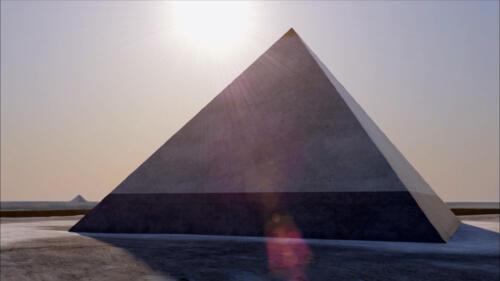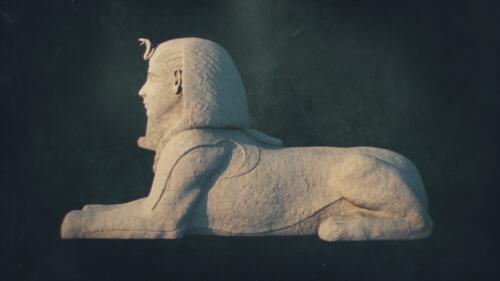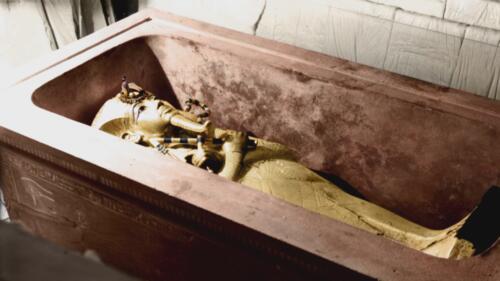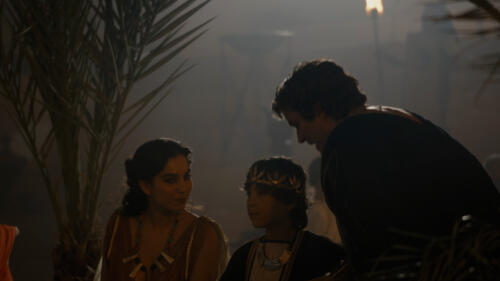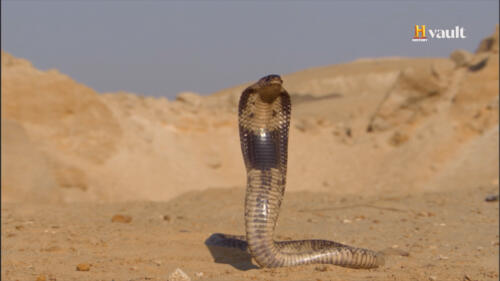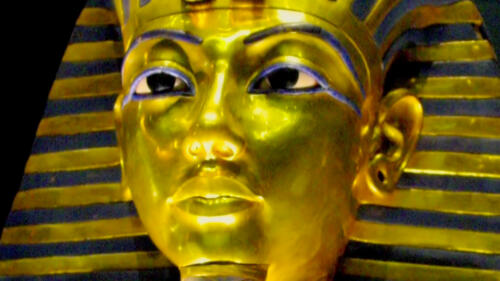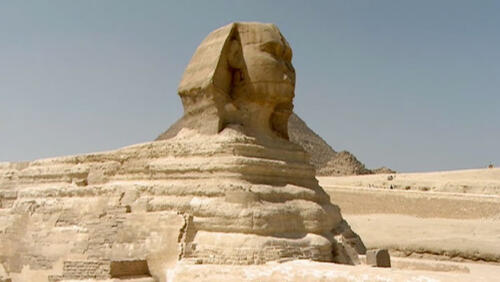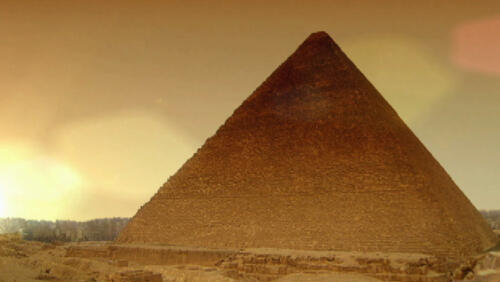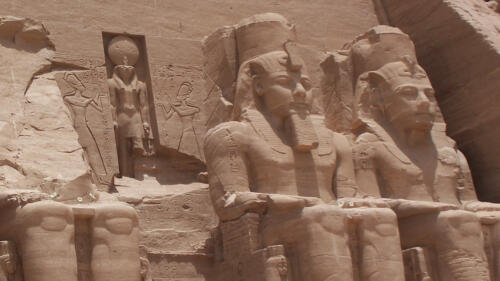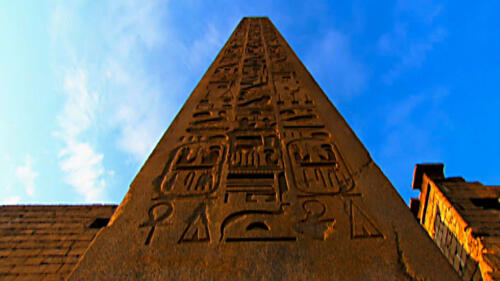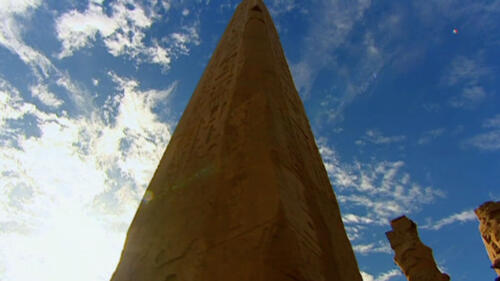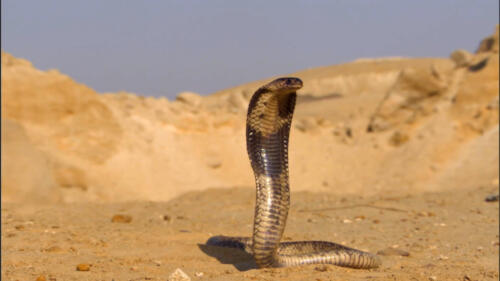Ancient Egypt
Ancient Egypt was home to one of the greatest empires in history, with leaders like Tutankhamen (King Tut), Cleopatra, Ramses II and landmarks like the Great Pyramid at Giza and the Sphinx.

Start Here

Built during a time when Egypt was one of the richest and most powerful civilizations in the world, the pyramids—especially the Great Pyramids of Giza—are some of the most magnificent man-made structures in history.

The venom of an asp—or even a cobra—supposedly killed the legendary queen of Egypt. Is it true?

A volcanic eruption and shift in climate could have triggered a series of ancient calamities—from pestilence to locusts—as described in the Bible.

A dagger crafted from meteorite and the remains of King Tut's stillborn daughters are among the stunning artifacts found in the tomb.
Cleopatra Becomes Queen of Egypt
Ancient Empires: Cleopatra Becoming a Queen
Following the death of her father, Ptolemy XII Auletes, Cleopatra is crowned Queen of Egypt.
3 Everyday Objects of Ancient Egypt
Explore All Related Topics

Founded in the third century B.C., the library held a vast collection of ancient texts on science, philosophy and literature.

Most may associate mummy-making with ancient Egypt, but evidence suggests the practice dates back thousands of years earlier.

A 3,000-year-old fresco from an accountant's tomb depicts hunting, fishing and outdoor feasting.

The pharaoh’s 3,200-year-old mummy hasn’t revealed a specific cause of death, but old age was likely an overriding factor.

Built in the third century B.C., the towering structure was among the seven wonders of the ancient world.

The bee byproduct has been around for millennia—and not just as a sweetener.

The challenge lies in defining what qualifies as a civilization.

Few ancient sculptures survive the passage of time unscathed.

The answer depends on how you frame the question.

The position of her mouth suggests this ancient Egyptian woman may have died in agony, possibly while screaming either in pain or fear.

History is filled with tortured stories of people drinking gold, transfusing blood and taking potions to defy death.

For millennia, ancient Egyptian doctors were trailblazers—and evidence detected on skulls suggests its doctors may have even attempted to treat cancer.

A volcanic eruption and shift in climate could have triggered a series of ancient calamities—from pestilence to locusts—as described in the Bible.

To consolidate power, the last queen of Egypt married—then killed—her siblings. And she bore children with Roman allies Julius Caesar and Mark Antony.

The artifact, picked up by a retiree walking on a beach in Israel, depicts one of the most powerful deities of ancient Egypt.

A dagger crafted from meteorite and the remains of King Tut's stillborn daughters are among the stunning artifacts found in the tomb.

The once-great empire on the Nile was slowly brought to its knees by a centuries-long drought, economic crises and opportunistic foreign invaders.

Ancient Egyptians left behind a trove of artifacts that shed light on daily life during the civilization's 3000-year existence.

Felines served a useful purpose in ancient Egyptian households and were eventually associated with deities.

The script found on the insides of ancient Egyptian temples, monuments and tombs represents a complex remnant of history.

From axes to swords to chariots, see the weapons that helped make ancient Egyptian warriors formidable.

Dig into the superstitions that surround King Tut’s tomb, the Hope Diamond and more.

The venom of an asp—or even a cobra—supposedly killed the legendary queen of Egypt. Is it true?

From King Tut's tomb to the pyramids, here are the greatest archaeological finds from Egypt.

Decades of research and high-tech forensics have offered multiple theories.

An upgrade of the Boy King's burial chamber took a decade.

Here are the most fascinating finds of the year.

The ancient tombs contained a well-preserved woman and the priest responsible for embalming the pharaohs.

The discovery of a 4,500-year-old ramp offers clues about Egyptians' technological knowledge.

A years-long hunt ended in disappointment—and Nefertiti’s tomb remains elusive.

These razor-sharp blades inspired fear and fascination and helped change the course of military campaigns.

The Great Sphinx of Giza is a 4,500-year-old statue near Egypt's Great Pyramid. At 240 feet long and 66 feet high, it is one of the world's largest monuments.

Unlike Hollywood portrayals with outstretched arms and shuffling feet, mummies are persons or animals whose bodies have been dried or otherwise preserved after death.

From ancient Roman bacchanalia to the Shah of Iran's $175 million birthday party, these are some of history's most epic bashes.

Archaeologists say a pair of dismembered, mummified legs found inside an ancient Egyptian tomb are most likely those of the famed Queen Nefertari, consort of King Ramses II.

Egypt’s oldest papyrus fragments, which detail the construction of the Great Pyramid of Giza, have gone on public display in Cairo.

The iron blade of an ornate dagger buried with Egypt’s King Tutankhamun in the 14th century B.C. likely came from a fallen meteorite, according to a new study.

CT scan images suggest that as one assailant slit Ramses III’s throat, another severed his right big toe.

A British archaeologist believes ancient Egypt’s Queen Nefertiti may be buried behind a secret door inside of King Tut’s tomb.

Check out 10 surprising facts about the fabled Queen of the Nile.

Estimates suggest the project took about two decades to complete.

British scientists have uncovered a secret at the heart of ancient Egypt’s large cache of animal mummies—many of them contain no animal remains at all.

An Italian researcher has concluded that a painting some have called the ancient Egyptian equivalent of DaVinci’s “Mona Lisa” is probably a fake.

The Ancient Egyptian slab helped crack the code of hieroglyphics.

The longest river in the world, measured from its mouth to its most distant, year-round source, is likely the Amazon, which flows 4,345 miles from the Peruvian Andes through Brazil to the Atlantic Ocean. However, much depends on how you measure it. Until 2007, the title belonged to the Nile, which runs 4,258 miles from […]

Six surprising facts about the Egyptian boy king and his final resting place.

Today, mummies are some of the most prized and highly valued artifacts of antiquity, but it might surprise you to know that prior to the 19th century, this wasn’t always the case.

In early 1923, British archaeologist Howard Carter and his financier friend George Herbert, Lord Carnarvon, ceremoniously opened the long-obscured burial chamber of the boy pharaoh Tutankhamen in Egypt’s Valley of the Kings. Two months later, Carnarvon was dead, killed by blood poisoning from an infected mosquito bite on his cheek. Newspapers speculated that he was […]

From the earliest recorded peace treaty to ancient board games, discover 11 surprising facts about the Gift of the Nile.

Queen Nefertiti (1370-c. 1330) ruled Ancient Egypt with her husband Akhenaten (aka Amenhotep IV). She was reknown for her beauty, as depicted by her limestone bust, one of the most recognizable works of Egyptian art.

Hatshepsut oversaw ambitious building projects, including the Temple of Deir el-Bahri, during her reign in 15th century B.C. as a rare Egyptian female pharaoh.

Tutankhamun, or simply King Tut, ruled Egypt as pharaoh until his early death. Howard Carter found his tomb intact, setting off a worldwide Egyptology frenzy.

Cleopatra VII ruled ancient Egypt as co-regent for almost three decades. She is famed for her savvy political alliances with Julius Caesar and Mark Antony.

Famous tombs around the world include the Egyptian tombs, Jesus’ burial ground in Jerusalem, the Prophet’s Mosque and many more.

Built during a time when Egypt was one of the richest and most powerful civilizations in the world, the pyramids—especially the Great Pyramids of Giza—are some of the most magnificent man-made structures in history.

Ancient Egypt was the preeminent civilization in the Mediterranean world from around 3100 B.C. to its conquest in 332 B.C.
